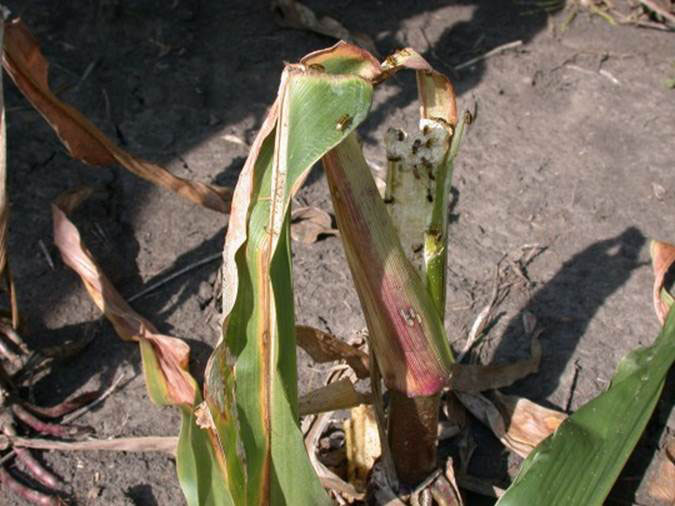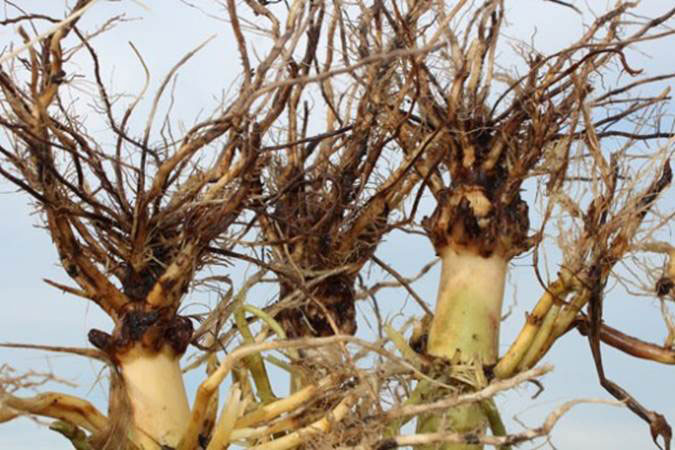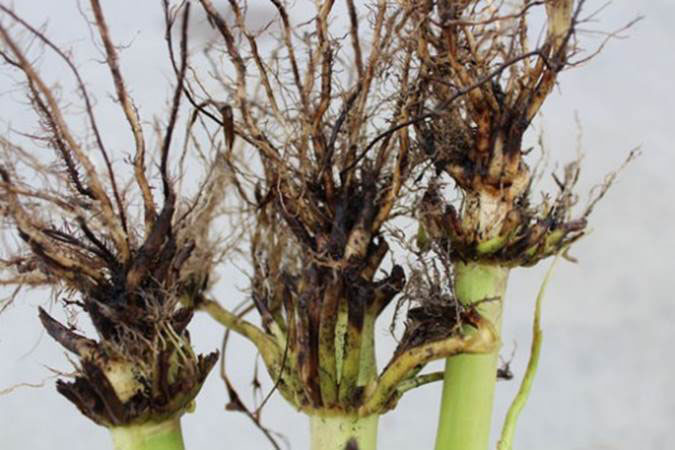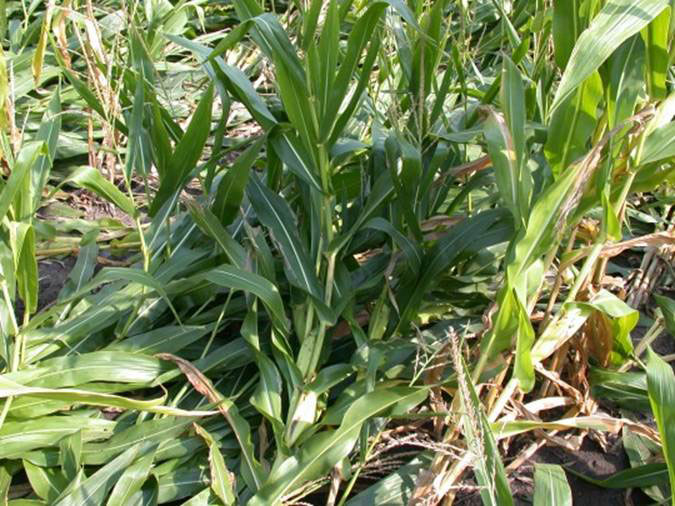Crop rotation strategies not alleviating Bt resistance in Illinois Dr Eva Sirinathsinghji
New evidence from two Illinois farms shows that even integrated pest management strategies such as crop rotation are unable to stave off the spread of Bt pest resistance to genetically modified (GM) Bt corn [1]. After planting Monsanto’s VT Triple PRO RIB corn containing the insecticidal Cry3Bb1 toxin for the first time, the farmers from Livingston and Kankakee counties saw severe damage to their corn as well as soybeans grown in adjacent fields. They went on to contact entomologists Dr Joe Spencer and Dr Michael Gray from the University of Illinois to come and analyse the damage.
The first official evidence of resistance to Bt toxins in the field was published in 2010 [2] (see [3] Bt Rootworm Spreads, SiS 52). Since then, GM proponents have claimed that a lack of compliance by farmers to include a refuge area of non-GM corn, as well as dropping traditional pest management strategies of crop rotation were the underlying reasons for the development of such rapid resistance to Monsanto’s Bt crops. However, in both the present cases, the farmers have stuck to crop rotation strategies only to find a complete failure of Monsanto’s GM technology to do its job. The crops are suffering from large numbers of pests (Figure 1), severe root pruning (Figure 2) and damage (Figure 3) as well as lodging of the plants (Figure 4). Pest numbers were reportedly comparable to levels seen in the late 1990s and early 2000s. Further lab tests are planned to confirm genetic Cry3Bb1 resistance in the pests themselves. The scientists are now warning farmers that they may face serious challenges in protecting their crops.
The process of crop rotation is meant to delay the time needed by pests to adapt to the toxin and gain resistance. Monsanto states that every grower of their Bt crops must comply with licensing agreements that include an Integrated Pest Management plan with crop rotation, the planting of non-GM refuge areas, as well as selecting appropriate cultivars among other things [4]. The company claims that growers of its crops “have found them to be highly compatible with their goals of integrated pest management (IPM) and sustainable agriculture”. However, the refuge strategy depends on high expression of the Bt toxins, but as mentioned earlier, this is not the case. Also, Monsanto managed to successfully persuade the US Environmental Protection Agency (EPA) to reduce the size of the non-GM refuge to 10 % instead of 50 % [3]. Now, on top of all that, the crop rotation has been shown insufficient to control the spread of Bt resistance in target pests. Monsanto simply cannot keep claiming that their crops work.

Figure 1 Corn rootworm infestation of Monsanto’s VT Triple PRO RIB Bt corn [1]

Figure 2 Pruning of roots of Monsanto’s VT Triple PRO RIB Bt corn plants by rootworm infestation [1]

Figure 3 Rootworm damage Monsanto’s VT Triple PRO RIB Bt corn [1]

Figure 4 Lodging of Monsanto’s VT Triple PRO RIB Bt corn plants resulting from corn rootworm damage [1]
The evolution of pesticide resistance pests is all too predictable to anyone who understands the process of evolution or farming. Even Monsanto admits that “resistance is natural and expected, so measures to delay resistance are important” [5]. All the more so when we learn that some of Monsanto’s Bt crops express the toxin at insufficient levels to prevent the development of non-recessive resistance. Non-recessive resistance is when the resistance gene is dominant and therefore only requiring one copy (heterozygosity) of the gene to be resistant to the toxin. Recessive resistance on the other hand would require two copies of the resistance gene to make the pest resistant and therefore, resistance would spread more slowly. Agritech companies have seized the opportunity for easy profit following mass cultivation of Bt crops; American Vanguard, for example, bought a number of insecticide companies and technologies with the expectation that pesticide demand would rise after an temporary dip when Bt crops were initially commercialised [6]. Contrary to what GM corporations and proponents claim, overall pesticide use has risen as a direct result of GM crop cultivation, mainly attributable to massive rises in glyphosate use alongside glyphosate-tolerant crops. Pesticide use has gone down since the introduction of Bt crops, but is rising again and if Bt crops were counted as “pesticides applied”, and there is a strong case to do so, then insecticide use never went down at all (see [7] Study Confirms GM Crops lead to increased Pesticide Use, SiS 56). The spread of resistance will only lead to further increases in toxic chemicals being applied to our food, leaving consumers exposed to double doses of toxic insecticides. Chemical companies have seen profits rise, with The Newport Beach, Calif. reporting its soil-insecticide revenue jumped 50% in 2012. Its insecticide sales rose 41% in the first quarter of 2012 to $79 million, with gains driven by corn insecticide [6].
Not only are the Bt crops unable to do the two things they were meant to do - protecting crops from pests and reducing pesticide use - they are also having detrimental effects on non-target pests, and causing the infestation of crops with secondary pests even when the Bt crop is still able to kill the target pests. Further, Bt crops have been shown to cause health problems to those cultivating them as well as those consuming them. For a review on the health and environmental risks of Bt crops see [8] Bt Crops Failures and Hazards, SiS 53 and [9] Ban GMOs Now.
Article first published 16/09/13
Comments are now closed for this article
There are 3 comments on this article.
Monsanto go home Comment left 16th September 2013 22:10:53
We surpass Monsanto with your "like me" for the network "Monsanto go home"
FOR A WORLDWIDE NETWORKING ALL GROUPS, PEOPLE und PEOPLES TO SAY NO TO GMO
https://www.facebook.com/gohomemonsanto
Please like as and invite all your friends an and share it! Thank you!
For more information visit http://networkmonsanto.eulu.info
Deborah Liguori Comment left 16th September 2013 22:10:46
Mainstream media controls what the average person knows about gmos. This is an excellent article and educating the masses with these edu.site/articles is so important. Whenever I share what research I have found on gmos at first people look at me like I have two heads. After setting up a table at our local farmers market with research based info on gmos for a few months now I am suddenly getting great responses. From a retired nurse to a care home giver to young people as well as grandparents concerned about the rise in health problems I am seeing an awareness. Thanks for your work. Our government has been bought out and we have to work together to raise awareness to protect our generations as well as the environment.2
Gene Sperling Comment left 17th September 2013 02:02:06
All this, and there was not even mention of the fact that Monsanto, through their government connections, has proposed an increase of 10% for the allowable levels of glyphosate residue in foods and humans.
When will it stop.
Please include the name of Barak Obama in the list of "Friends of Monsanto".